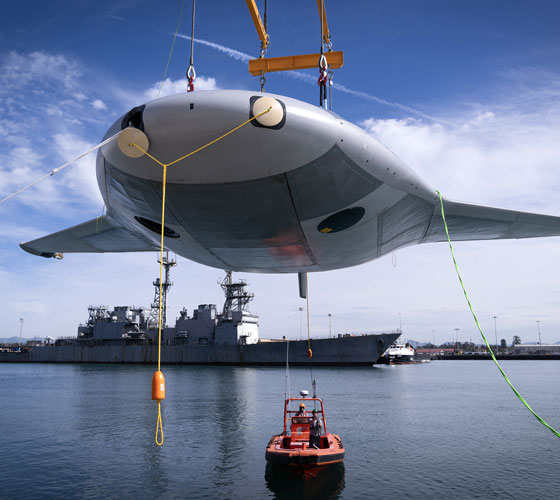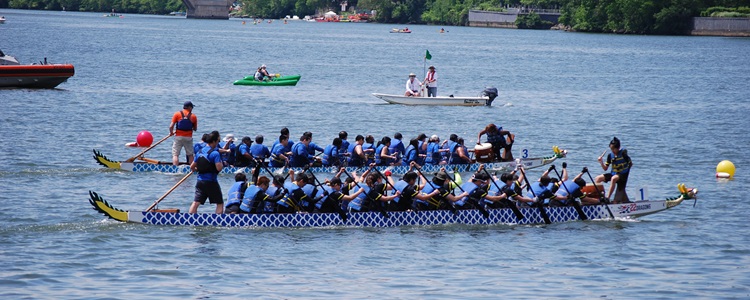The Raider will provide long range, high survivability and mission payload flexibility.
Beneath the Surface
Building Manta Ray, DARPA’s Uncrewed Underwater Vehicle

By Mariah Pulver
It started with a challenge – how could we help the U.S. military conduct extended undersea missions?
In 2020, the Defense Advanced Research Projects Agency (DARPA) released a request for proposals on a new class of uncrewed underwater vehicle (UUV). Their request sought to advance capabilities in energy management, efficiency, power, fueling and more for long-range and long-duration missions.
Undersea missions can be very difficult, with challenges like high pressure, low temperatures, spotty communications and power supply for long missions, especially when operating far from port. What we needed was an advanced UUV that was bigger, more efficient and autonomous, or able to act independently without human supervision.
Northrop Grumman answered the call. We designed, built and, earlier this year, tested Manta Ray, our full-scale UUV that will voyage to the depths of the ocean on extended missions.
Here are four benefits of this new technology.
1) Saving Energy for Long Missions
Manta Ray has a unique size and shape that allows it to save power and energy for long missions. It is classified as an extra-large glider UUV, or XLUUV.
GIiders are a type of UUV that have been used since the 1960s to explore the ocean. Organizations like DARPA, the U.S. Navy and the National Oceanic and Atmospheric Administration use gliders to gather data on lengthy missions.
“A glider has a really intriguing propulsion mechanism, falling forward [with purpose] through the water all the time, both upward and downward,” said Brian Theobald, principal investigator and chief engineer for Manta Ray at Northrop Grumman. “When Manta Ray needs to go up or down, it changes buoyancy by pumping sea water to change the weight of the vehicle.”
Gliders only need to change buoyancy for a few minutes at the top or bottom of their path. The rest of the time, they glide forward using minimal power and energy. This technology makes gliders operate more efficiently, which will enable Manta Ray to save power for long missions.
2) Sizing Up with Room for Critical Payloads
The U.S. Navy defines XLUUVs as vehicles that are too large to launch off a ship or submarine; instead, they are launched from a pier.
Manta Ray’s extra-large size provides endurance, with more room for power systems, and the ability to carry critical payloads or sensors for a variety of long-range, long-duration missions.
“Our team had to be creative and innovative to find solutions that would work for a glider UUV as big as Manta Ray,” said Structural Engineer Hayley Sypniewski. “It’s not a one-to-one scale with typical glider UUVs; because of its size, we added more buoyancy engines, a bigger payload bay, an enhanced towing system and an extremely efficient and large hull system.”
3) Conducting Missions Worldwide
How do you ship a UUV of this size around the world for missions? You split it up.
Most large undersea vehicles, like submarines, are so big when fully assembled that they can’t be put on a truck or ship to transport. Our engineers designed Manta Ray with these considerations in mind. Thanks to its modular design, Manta Ray can be separated into parts for easy shipping. Then, it can be assembled in-field.
With missions around the world, the U.S. military and our allies must be expeditionary. Manta Ray allows them to bring critical capabilities wherever they are needed.
4) Operating Autonomously to Keep Our Military Safe
In January 2024, our team in Maryland shipped Manta Ray to Southern California for in-water testing.
During the tests, Manta Ray demonstrated its ability to glide, ascend and descend, turn, hover and anchor. It can do some of these skills autonomously, avoiding the need for on-site human logistics or a human captain.
“Manta Ray’s uncrewed capability is critical because we want to keep humans out of harm’s way during long missions in potentially dangerous environments,” said Joe Deane, Manta Ray program manager.
Manta Ray solves a unique mission set in a ground-breaking way. By extending the range and capabilities of XLUUVs, Manta Ray can complete missions in challenging undersea environments, while keeping our warfighters safe.
Learn more about Manta Ray, and if you’re interested in helping us do work that’s defining possible, check out our career opportunities. You can also explore what life is like working at Northrop Grumman.


